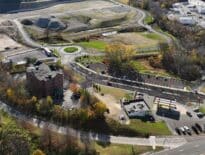
New decarbonization regulations on an estimated 6,000 buildings in Boston are forcing landlords to draw up plans to reduce emissions or face fines. iStock illustration
Boston’s groundbreaking law cutting large buildings’ greenhouse gas emissions is set to gain a set of teeth, and city regulators are scrambling to set up the final enforcement rules.
Hospitals, universities, museums and office landlords all have warned of potential hardships complying with the Building Emissions Reduction and Disclosure Ordinance (BERDO), which sets carbon dioxide emissions reduction goals and threatens potential fines beginning in 2025. A real estate industry group said BERDO could force apartment landlords to raise rents to cover the costs of building retrofits, such as installation of electric heating systems.
Buildings comprise approximately 70 percent of the city’s greenhouse gas emissions, according to climate studies, and the new law applies to an estimated 6,000 of the largest commercial and multifamily buildings.
“For a lot of the smaller building owners, this is going to be new,” said Mark Walsh-Cooke, Americas East property leader for engineering consultants Arup. “If people haven’t already, it’s now time to engage and to start putting a plan together.”
First Deadline Approaches
The first major milestone arrives May 15, the deadline for many property owners to submit data and compliance plans, followed by a July 1 deadline to submit hardship requests.
Many office landlords in Boston are expected to seek hardship waivers because of record vacancy rates, said Anastasia Daou, vice president of policy and public affairs for commercial developer group NAIOP Massachusetts.
“We really urge that to be a consideration in their review of hardship plans, understanding many of these owners will be submitting them just because the economics don’t work,” Daou said.
Approved by the Boston City Council in 2021, BERDO is designed to encourage decarbonization through the replacement of oil- and gas-fired utility systems, and sourcing of electricity from non-fossil fuel origins. The city’s Air Pollution Control Commission finalized the regulations in December.
Beginning in 2025, the ordinance sets specific energy reduction goals for buildings 35,000 square feet and up, or at least 35 housing units. In 2030, the law begins to apply to buildings at least 15,000 square feet or containing 15 to 34 housing units.
Buildings’ reduction targets vary depending upon use, reflecting the range of emissions from power-hungry manufacturing buildings to comparatively efficient offices and apartments. The law sets a goal of all buildings hitting net zero emissions standards by 2050.
In last week’s State of the City address, Boston Mayor Michelle Wu also promised more green building requirements to come. This year, the administration will introduce a net zero zoning code, Wu announced. The Boston Planning & Development Agency has been studying a building standard that prioritizes low-carbon building construction practices and the use of on- or off-site renewable energy sources, according to BPDA documents.

BERDO is designed to encourage decarbonization through the replacement of oil- and gas-fired utility systems in apartments and other commercial buildings, and sourcing of electricity from non-fossil fuel origins. iStock illustration
Office, Apartment Owners Object
The Greater Boston Real Estate Board has warned that the new regulations prodding building owners toward energy retrofits will further drive up rents and aggravate the housing affordability crisis.
In a public comment letter, GBREB said the process for applying for a hardship compliance plan is “onerous and unclear in some areas” and will force building owners into short-term decisions.
Health care organizations have asked for a separate hardship category for hospitals, health care facilities and biomedical buildings. Much of the sector’s energy usage is mandated by federal regulations, according to a comment letter submitted by the Conference of Teaching Hospitals, Longwood Collective and Longwood Medical Energy Collaborative.
“Health care is interesting because they have a lot of unique challenges,” said Yve Torrie, director of climate, energy and resilience at business group A Better City. “They have many layers that are operational 24-7, so even if they go all-electric, they have to have backup systems that are federally mandated.”
Owners of affordable housing properties also are concerned about the financial implications of complying, said Chris Schaffner, CEO of The Green Engineer, a Concord-based environmental consulting firm.
“We’ve been working with some nonprofits and some of them are in a tough situation about how they are going to be able to do these. They don’t have the cash sitting around,” Schaffner said.
Cultural institutions such as ICA Boston and the Museum of Fine Arts have weighed in about the need to maintain precise building environments to protect artwork. And landlords with restaurant tenants are concerned about the implications of removing gas utilities, Arup’s Walsh-Cooke said.
Landlords that fail to comply face fines of up to $300 per day. New York City, which implemented a similar green building law in 2019, approved a two-year delay on fining building owners in 2023 after the Real Estate Board of New York complained of damage to the local economy.
While the ordinance is designed to encourage potentially costly building retrofits, building owners have other options to comply.
Reduction of emissions related to electricity usage can be attained through purchases of renewable energy credits, Arup’s Walsh-Cooke said, which would not increase costs dramatically. Fossil fuel-based heating and electric systems can be replaced by electric heat pumps, or tie-ins to district energy systems from non-carbon sources.
Requested: A Cheat Sheet for Landlords
Commercial landlords also want more specifics from City Hall on the basics of submitting the required paperwork.
“We’d asked for a cheat sheet that has all of the requirements in a one-page flowchart,” NAIOP’s Daou said. “I know that sounds rudimentary to ask for, but we have heard from our members: ‘What do I have to do and when?’ We continue to urge clear communication from the city.”
In approving the final regulations in December, the city’s Air Pollution Control Commission signaled that it will give building owners some leeway in BERDO’s initial stages. The final version removed the word “unusual” among the circumstances required to request a hardship, which had been requested by some commenters.

Steve Adams
As the new law shifts to implementation, Boston is setting up a new bureaucracy to oversee enforcement. The eight-member BERDO Review Board will review applications from property owners seeking hardship compliance plans, exempting them from compliance for a limited period of time.
At a meeting last week, BERDO Review Board members acknowledged the daunting scope of their responsibilities and the lack of specifics on compliance.
The board has not released a hardship application form “because hardships are so tailored and subject to the individual applicant,” Review Board Manager Diana Vasquez said. Property owners are expected to submit a narrative on their hardship and alternatives to compliance.
The commission will hold a webinar in coming weeks to provide further details, Vasquez said.




 |
| 

